|
|
|
Sort Order |
|
|
|
Items / Page
|
|
|
|
|
|
|
| Srl | Item |
| 1 |
ID:
116510
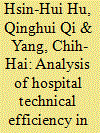

|
|
|
|
|
| Publication |
2012.
|
| Summary/Abstract |
This paper investigates the regional hospital efficiency in China during the 2002-2008 period, especially for how the health insurance reform of New Rural Cooperative Medical System (NRCMS) impacts on efficiency. Adopting the non-parametric technique of data envelopment analysis (DEA) to handle the feature of multiple outputs and undesirable outputs in the hospital industry, empirical estimates indicate that hospital efficiency is moderate that increased slightly from 0.6777 to 0.8098 during the sample period. However, it ranges widely from 0.396 to 1 across provinces. The regression analysis on examining determinants of efficiency suggests that a higher proportion of for-profit hospital and high quality hospital is helpful to enhance technical efficiency. We find a negative relationship between government subsidy and efficiency for coastal regions. While technical efficiency varies considerable across provinces, there is no significant difference between coastal and non-coastal regions being found, after controlling for other variables. Crucially, the medical reform of NRCMS overall has a significant efficiency-enhancing effect, particularly for non-coastal regions, ceteris paribus. It highlights the effectiveness of NRCMS on promoting medical service accessibility for rural residents.
|
|
|
|
|
|
|
|
|
|
|
|
|
|
|
|
| 2 |
ID:
166992


|
|
|
|
|
| Summary/Abstract |
In accordance with the commitment of China to reducing emissions consistent with the Kyoto Protocol, the total carbon emissions of the nation mandatorily require fair allocation to all of the provinces in order to properly handle the relationship between development and emissions reduction. The current paper carries out an evaluation of the status of carbon emissions in China for the year 2012. Considering the viewpoint of Max-min satisfaction, the data envelopment analysis (DEA) is applied for the achievement of a fixed cost allocation. Through the comparison of the allocated amount of carbon emissions with the actual carbon emissions, we perform an analysis and evaluation of the use of carbon emission rights in all provinces. Two of the key findings are presented as follows: The utilization rate of carbon emission in eastern China is termed as the lowest, followed by the utilization in central China. However, the utilization rate of carbon emission in the western region is considered as the best. On the basis of our analysis, guidelines are put forward for a production plan that incorporates energy saving as well as emission reduction.
|
|
|
|
|
|
|
|
|
|
|
|
|
|
|
|
| 3 |
ID:
092738
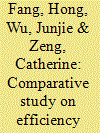

|
|
|
|
|
| Publication |
2009.
|
| Summary/Abstract |
Continually rising energy prices in global markets highlights a serious concern about the need to improve energy efficiency and the efficiency in energy sector in many countries. China, as one of the fastest growing countries in the world and the largest coal producer, has high coal consumption but a low recovery rate of coal utilization. Coal efficiency and the efficiency in coal industry have therefore attracted a great deal of attention from Chinese policy makers, coal firms and academics. This study attempts to compare the relative technical efficiency performance of listed coal mining companies in China and the US using CCR and BCC models in the advanced DEA linear programming. The results show that the level of relative efficiency in Chinese coal mining enterprises, regardless of total technical efficiency or decomposed pure technical and scale efficiency, is much lower than in American coal firms. The study also highlights the input resources that cause the inefficiency of Chinese coal mining companies. Furthermore, in-depth discussion and analysis of how the institutional environments of the two countries could cause the differences are provided.
|
|
|
|
|
|
|
|
|
|
|
|
|
|
|
|
| 4 |
ID:
121333
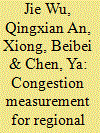

|
|
|
|
|
| Publication |
2013.
|
| Summary/Abstract |
The industry in China has been developing extensively in the last few decades. Large investments in China's industry may cause congestion because congestion is a widely observed economic phenomenon in such a scenario. In order to know the performance and allocate resources well, it is necessary for the Chinese government to measure congestion of the industry. Many scholars have studied this topic by means of data envelopment analysis (DEA). However, previous studies only pay attention to the framework of desirable outputs. In fact, undesirable outputs often accompany desirable outputs in production. Thus, in this study, a new approach for measuring congestion with undesirable outputs is proposed and applied to analyzing congestion of the industry in 31 administrative regions of China. The results show that five regions have congestion in their industry in 2010. Besides, the regions located in the east of the country perform the best in ecological efficiency, followed by regions in central and west China. Based on these findings, this paper proposes some political schemes to improve regional industrial efficiency.
|
|
|
|
|
|
|
|
|
|
|
|
|
|
|
|
| 5 |
ID:
137978


|
|
|
| 6 |
ID:
094383


|
|
|
|
|
| Publication |
2010.
|
| Summary/Abstract |
This study adopts a bank production function approach to the measurement of efficiency of the Chinese state-owned commercial banking groups at the provincial level from 1998 to 2003. Applying Data Envelopment Analysis and efficiency decomposition analysis, this paper for the first time presents detailed empirical evidence on the technical efficiencies of the Chinese state-owned commercial banks across both the provinces and banking groups. The empirical evidence has revealed limited effects of the banking reform programmes and highlighted the need to encourage spatial competition and corporate governance reform across Chinese provinces and to take differential strategies to further improve operational efficiency at the provincial branch level.
|
|
|
|
|
|
|
|
|
|
|
|
|
|
|
|
| 7 |
ID:
111449


|
|
|
|
|
| Publication |
2012.
|
| Summary/Abstract |
The paper provides an empirical assessment of the electricity efficiency improvement potential in the Swedish pulp and paper industry by employing data envelopment analysis (DEA) and mill-specific input and output data for the years 1995, 2000 and 2005. The empirical results are discussed in relation to the reported outcomes of the Swedish voluntary energy efficiency programme PFE. The estimated electricity efficiency gap is relatively stable over the time period; it equals roughly 1 TWh per year for the sample mills and this is three times higher than the corresponding self-reported electricity savings in PFE. This result is largely a reflection of the fact that in the pulp and paper industry electricity efficiency improvements are typically embodied in the diffusion of new capital equipment, and there is a risk that some of the reported measures in PFE simply constitute an inefficient speed-up of capital turnover. The above does not preclude, though, that many other measures in PFE may have addressed some relevant market failures and barriers in the energy efficiency market. Overall the analysis suggests that future energy efficiency programs could plausibly be better targeted at explicitly promoting technological progress as well as at addressing the most important information and behaviour-related failures.
|
|
|
|
|
|
|
|
|
|
|
|
|
|
|
|
| 8 |
ID:
122736
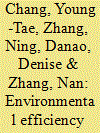

|
|
|
|
|
| Publication |
2013.
|
| Summary/Abstract |
Many countries are worried about reducing energy consumption and environmental pollution while increasing the productivity and efficiency of their industries. This study intends to contribute to the literature by proposing a non-radial DEA model with the slacks-based measure (SBM) to analyze the environmental efficiency of China's transportation sector. The results show that most of the provinces in China do not have an eco-efficient transportation industry. The environmental efficiency levels in most of the provinces are lower than 50% of the ideal or target level. Therefore, China's transportation industry is environmentally very inefficient. China can reduce a great deal of carbon emissions in each province ranging from at least 1.6 million TOEs in Qinghai and at most 33 million TOEs in Guangdong and Shanghai.
|
|
|
|
|
|
|
|
|
|
|
|
|
|
|
|
| 9 |
ID:
095937
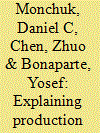

|
|
|
|
|
| Publication |
2010.
|
| Summary/Abstract |
In this paper we examine more closely the factors associated with production inefficiency in China's agriculture. The approach we take involves a two-stage process where output efficiency scores are first estimated using data envelopment analysis, and then in the second stage, variation in the resulting efficiency scores is explained using a truncated regression model with inference based on a semi-parametric bootstrap routine. Among the results we find that a heavy industrial presence is associated with reduced agricultural production efficiency and may be an indication that externalities from the industrial process, such as air and ground water pollution, affect agricultural production. We also find evidence that counties with a large percentage of the rural labor force engaged in agriculture tend to be less efficient, and suggests that nurturing and promoting growth of non-primary agriculture may lead to more efficient use of labor resources in agriculture.
|
|
|
|
|
|
|
|
|
|
|
|
|
|
|
|
| 10 |
ID:
159018
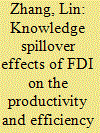

|
|
|
|
|
| Summary/Abstract |
As China is moving toward an innovation-driven economy, this paper offers new insights for both policymakers and investors to optimize the effectiveness of investment performance. This paper studies China's provincial research activities with a focus on the spillover-induced productivity and efficiency change. The results show that spillovers as a result of inflow of foreign investment contribute positively to the performance of overall research activities, however, the productivity effects vary across regions. Our analysis also indicates that highly skewed distribution of FDI leads to a less improved innovation efficiency in FDI-rich provinces. Future innovation policy should adjust the investment profiles based on the preferential innovation output on one hand, and optimize the complementary policy for FDI on the other hand to reduce inefficiency and the potential negative effects of knowledge spillovers. Inter-provincial governmental cooperation is necessary to resolve the uneven distribution of FDI and improve the innovation efficiency in both FDI-poor and rich regions.
|
|
|
|
|
|
|
|
|
|
|
|
|
|
|
|
| 11 |
ID:
103617


|
|
|
|
|
| Publication |
2011.
|
| Summary/Abstract |
Sueyoshi et al. (2009) have examined a synergy effect between electricity and gas services in the US electric utility industry. They have compared electricity-specialized firms with diversified utility firms in their financial performance and corporate value. A problem of their study is that it has not empirically measured the operational performance of the electric utility firms. As an extension of the preceding study, this research investigates the operational performance of 104 US electric utility firms (1990-2004) by fully utilizing DEA (Data Envelopment Analysis). This study finds the three new policy implications. First, the synergy effect has not existed in the operational performance of diversified utility firms before and after the deregulation on the US electricity markets. Thus, core business concentration is more effective for electric utility firms than corporate diversification to enhance their operational performance under the current US deregulation policy. Second, the operational performance has had an increasing trend until 1996 and a decreasing trend after 1996. Thus, the US deregulation policy has been influential on their operational performance. Third, the enhancement in operational performance of electric utility firms has improved their financial performance. The improvement in financial performance has increased their corporate value. Thus, this study finds the business causality among operational performance, financial performance and corporate value in the US electric utility industry.
|
|
|
|
|
|
|
|
|
|
|
|
|
|
|
|
| 12 |
ID:
094879


|
|
|
|
|
| Publication |
2010.
|
| Summary/Abstract |
Data envelopment analysis (DEA) has been widely used in energy efficiency and environment efficiency analysis in recent years. Based on the existing environment DEA technology, this paper presents several DEA models for estimating the aggregated efficiency of resource and environment. These models can evaluate DMUs' energy efficiencies and environment efficiencies simultaneously. However, efficiency ranking results obtained from these models are not the same, and each model can provide some valuable information of DMUs' efficiencies, which we could not ignore. Under this situation, it may be hard for us to choose a specific model in practice. To address this kind of performance evaluation problem, the current paper extends Shannon-DEA procedure to establish a comprehensive efficiency measure for appraising DMUs' resource and environment efficiencies. In the proposed approach, the measure for evaluating a model's importance degree is provided, and the targets setting approach of inputs/outputs for DMU managers to improve DMUs' energy and environmental efficiencies is also discussed. We illustrate the proposed approach using real data set of 30 provinces in China.
|
|
|
|
|
|
|
|
|
|
|
|
|
|
|
|
| 13 |
ID:
091555


|
|
|
|
|
| Publication |
2009.
|
| Summary/Abstract |
This article computes the energy productivity changes of regions in Japan using total-factor frameworks based on data envelopment analysis (DEA). Since the traditional DEA-Malmquist index cannot analyze changes in single-factor productivity changes under the total-factor framework, we apply a new index proposed by Hu and Chang [2009. Total-factor energy productivity growth of regions in China. Energy Policy, submitted for publication]: a total-factor energy productivity change index (TFEPI) that integrates the concept of the total-factor energy efficiency index into the Malmquist productivity index (MPI). Moreover, we separate TFEPI into change in relative energy efficiency, or the 'catching up effect,' and shift in the technology of energy use, or the 'innovation effect.' The data from 47 prefectures during the period of 1993-2003 are used to compute the TFEPI and its components for 4 kinds of energy. The TFEPI of electric power for commercial and industrial use changes ?0.6% annually, which can be separated into a total-factor energy efficiency change of 0.2% and a technical change of ?0.8%. The TFEPI for coal deteriorates by 1.0%/year, which is mostly caused by a decrease in relative energy efficiency change. We define and identify 'innovators' who cause the frontier to shift. Most regions identified as frontier shifters are located outside of Japan's four major industrial areas.
|
|
|
|
|
|
|
|
|
|
|
|
|
|
|
|
|
|
|
|
|